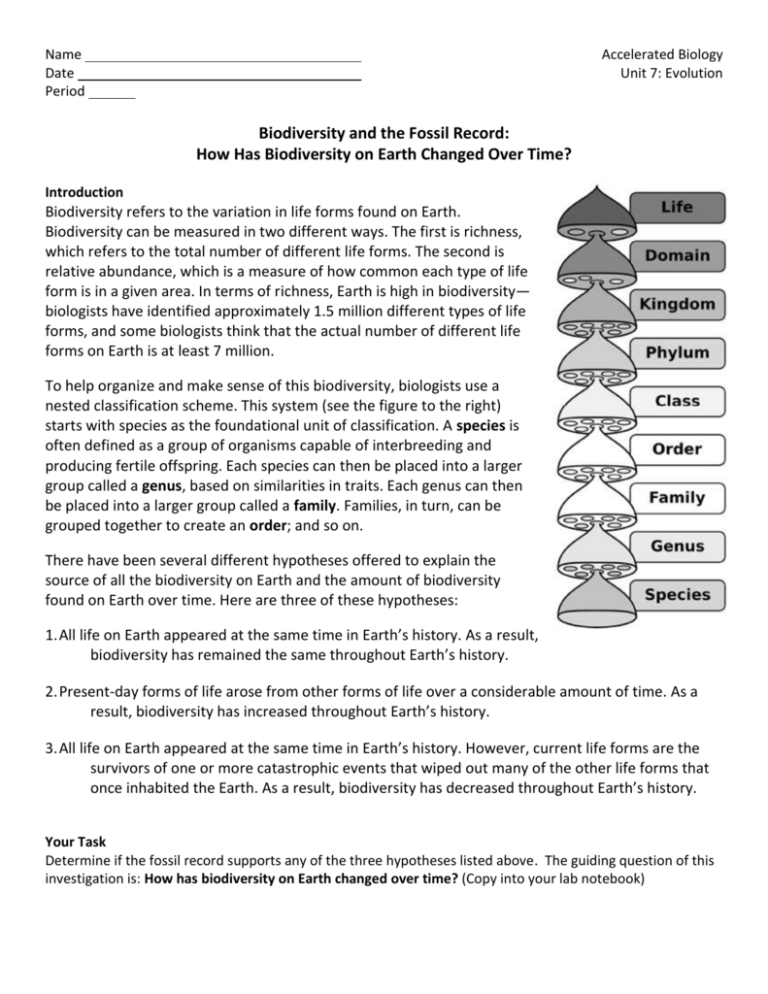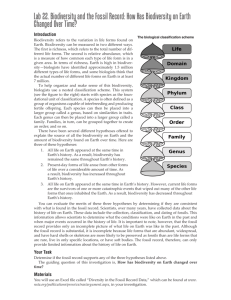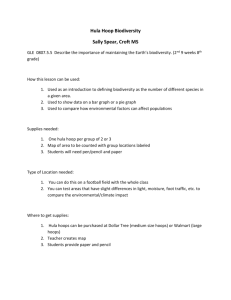Biodiversity and the Fossil Record: How Has
advertisement

Name Date Period Accelerated Biology Unit 7: Evolution Biodiversity and the Fossil Record: How Has Biodiversity on Earth Changed Over Time? Introduction Biodiversity refers to the variation in life forms found on Earth. Biodiversity can be measured in two different ways. The first is richness, which refers to the total number of different life forms. The second is relative abundance, which is a measure of how common each type of life form is in a given area. In terms of richness, Earth is high in biodiversity— biologists have identified approximately 1.5 million different types of life forms, and some biologists think that the actual number of different life forms on Earth is at least 7 million. To help organize and make sense of this biodiversity, biologists use a nested classification scheme. This system (see the figure to the right) starts with species as the foundational unit of classification. A species is often defined as a group of organisms capable of interbreeding and producing fertile offspring. Each species can then be placed into a larger group called a genus, based on similarities in traits. Each genus can then be placed into a larger group called a family. Families, in turn, can be grouped together to create an order; and so on. There have been several different hypotheses offered to explain the source of all the biodiversity on Earth and the amount of biodiversity found on Earth over time. Here are three of these hypotheses: 1. All life on Earth appeared at the same time in Earth’s history. As a result, biodiversity has remained the same throughout Earth’s history. 2. Present-day forms of life arose from other forms of life over a considerable amount of time. As a result, biodiversity has increased throughout Earth’s history. 3. All life on Earth appeared at the same time in Earth’s history. However, current life forms are the survivors of one or more catastrophic events that wiped out many of the other life forms that once inhabited the Earth. As a result, biodiversity has decreased throughout Earth’s history. Your Task Determine if the fossil record supports any of the three hypotheses listed above. The guiding question of this investigation is: How has biodiversity on Earth changed over time? (Copy into your lab notebook) Materials You will use an Excel file called “Diversity in the Fossil Record Data,” which can be found at www.nsta.org/publications/press/extras/argument.aspx, in your investigation. Getting Started In the data file, there are tabs for 10 different classes of organisms (Mammalia, Reptilia, Amphibia, and so on). Each tab includes information about all the families within that class that have been found in the fossil record. The dates represent the midpoint of different geologic stages. For example, 0.001 mya (million years ago) is the midpoint of the Holocene stage and 0.8 mya is the midpoint of the Pleistocene stage. The number 1 in a cell indicates that a fossil belonging to that particular family has been found for that time period. A question mark (?) in a cell indicates that a fossil is likely to be found for a specific time period (because there are fossils from that family in earlier and later time periods) but has not been discovered yet. Cells that are blank indicate that there are no fossils from that family in that time period. Record these in your lab notebook: hypothesis/claim, procedure, data, and analysis questions Digital Poster (Group) Once you have completed your research, you will need to prepare a digital poster that consists of three sections that provide answers to the following questions: 1. What question were you trying to answer and why? 2. What did you do during your investigation and why did you conduct your investigation this way? 3. What is your argument? Provide evidence from your study. Analysis Questions (answer with your lab notebook) 1. What does the fossil record suggest about how biodiversity on Earth has changed over time? 2. Evidence is data that have been collected by a scientist. a. I agree with this statement b. I disagree with this statement Explain your answer, using examples from your investigation about the fossil record. 3. Using an existing data set to test several hypotheses is an example of an experiment a. I agree with this statement b. I disagree with this statement Explain your answer, using information from your investigation about the fossil record. 4. Scientists often need to determine what is and what is not relevant at different time scales. Explain why this is important in science, using an example from you investigation about the fossil record. 5. Scientists often attempt to identify patterns in nature. Explain why the identification of patterns is useful in science, using an example from your investigation about the fossil record.







